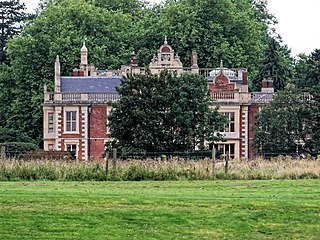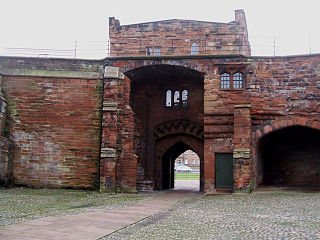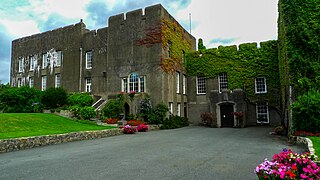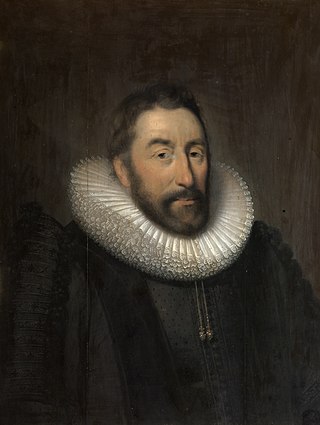Related Research Articles
Sir Henry St John (1590-c.1642) was an English politician who sat in the House of Commons between 1621 and 1625.

Spencer Compton, 2nd Earl of Northampton, styled Lord Compton from 1618 to 1630, was an English soldier and politician who sat in the House of Commons from 1621 to 1622. He became a peer by writ of acceleration in 1626 and by inheritance in 1630. He fought in the Royalist army and was killed in action at the Battle of Hopton Heath.

Sir Thomas Barrington, 2nd Baronet, 1585 to 18 September 1644, was an English politician and Puritan activist who sat in the House of Commons at various times between 1621 and 1644. In the early stages of the First English Civil War, he helped establish the Eastern Association, one of the most effective elements of the Parliamentarian army.

Sir John St John, 1st Baronet of Lydiard Tregoze in the English county of Wiltshire, was a Member of Parliament and prominent Royalist during the English Civil War. He was created a baronet on 22 May 1611.
Sir Richard Onslow was an English politician who sat in the House of Commons at various times between 1628 and 1664. He fought on the Parliamentary side during the English Civil War. He was the grandson of one Speaker of the House of Commons and the grandfather of another, both also called Richard Onslow.

Sir John Bampfylde, 1st Baronet of Poltimore and North Molton and Tamerton Foliot, all in Devon, was an English lawyer and politician. He was one of Devonshire's Parliamentarian leaders during the Civil War.

Oliver St John, 1st Earl of Bolingbroke, KB, known from 1618 until 1624 as 4th Baron St John of Bletso, was an English nobleman and politician.

Sir Edward Hungerford (1596–1648) of Corsham, Wiltshire and of Farleigh Castle in Wiltshire, Member of Parliament, was a Parliamentarian commander during the English Civil War. He occupied and plundered Salisbury in 1643, and took Wardour and Farleigh castles.

Sir Anthony Hungerford (1567–1627) of Black Bourton in Oxfordshire, Deputy Lieutenant of Wiltshire until 1624, was a member of parliament and a religious controversialist.
Sir Miles Sandys, 1st Baronet was an English landowner and politician who sat in the House of Commons at various times between 1614 and 1629.
Sir Richard Buller (1578–1642) was an English politician who sat in the House of Commons variously between 1621 and 1642. He was a Parliamentarian officer during the English Civil War.

Sir George Dalston (1581–1657) of Dalston Hall, Cumberland was an English politician who sat in the House of Commons of England between 1621 and 1643. He supported the Royalist cause in the English Civil War.
Sir Thomas Cheek, Cheeke or Cheke was an English politician who sat in the House of Commons in every parliament between 1614 and 1653.
Sir Beauchamp St John was an English politician who sat in the House of Commons variously between 1621 and 1653. He supported the Parliamentary side in the English Civil War.

Sir Anthony St John was an English Member of Parliament (MP) who sat in the House of Commons in 1624 and 1625. He supported the Parliamentary side in the English Civil War.
Oliver St John, 3rd Baron St John of Bletso was an English politician who sat in the House of Commons from 1588 until 1596 when he inherited the peerage as Baron St John of Bletso.
Sir Edward Rodney was an English politician who sat in the House of Commons at various times between 1621 and 1642.

Sir Walter Pye of The Mynde, Herefordshire was an English barrister, courtier, administrator and politician who sat in the House of Commons from 1621 and 1629.
Sir Edward Peyton, 2nd Baronet was an English landowner and politician who sat in the House of Commons at various times between 1621 and 1629. He fought for the Parliamentary cause in the English Civil War.
Sir Rowland St John KB was an English politician who sat in the House of Commons in 1614 and 1625.
References
- ↑ Archaeologia Cambrensis (1861)
- ↑ "Alexander St John (ST601A)". A Cambridge Alumni Database. University of Cambridge.
- ↑ Knights of England
- ↑ "ST. JOHN, Sir Alexander (c.1585-1657), of Renhold, Beds. and Tawstock, Devon; later of Shoreditch, Mdx. and Woodford, Northants". History of Parliament Trust. Retrieved 14 August 2019.
- ↑ Willis, Browne (1750). Notitia Parliamentaria, Part II: A Series or Lists of the Representatives in the several Parliaments held from the Reformation 1541, to the Restoration 1660 ... London. pp. 229–239.
- ↑ "Robert Wilkinson Londina Illustrata. Graphic and Historical Memorials of Monasteries, Churches, Chapels, Schools, Charitable Foundations, Palaces, Halls, Courts, Processions, Places of Early Amusement, and Modern Present Theatres, in the Cities and Suburbs of London and Westminster, Volume 2 St. John's House, Hoxton". Archived from the original on 20 July 2011. Retrieved 14 February 2011.